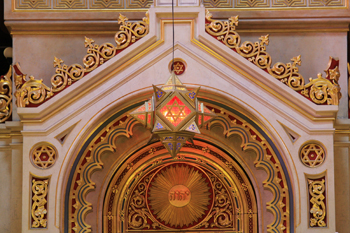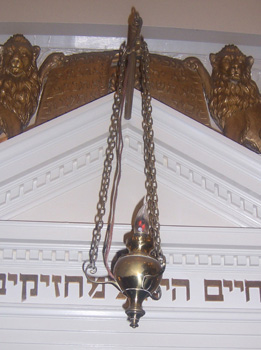Lily Dodge is a writer and community builder. She serves as the youth minister at Saint Mark's Episcopal Church in Palo Alto, California.
Every synagogue has a Ner Tamid, an Eternal Light that hangs somewhere above the Ark, where the Torah is kept. But the synagogue where I grew up in Phoenix was special. It had two Eternal Lights: one soft, glowing, golden one set high up in the towering Ark, and a bigger, brighter one like a traveler’s lamp that hung from the ceiling.
We got the bigger one because people who visited our synagogue kept complaining that we didn’t have a Ner Tamid, or asking where ours was. So the Rabbi installed a more obvious one to free up all the time she was spending showing newcomers how to find our little eternal light. Most members of the congregation would identify the new one as our Ner Tamid, but the old one was always my favorite. I knew where to find it. I knew how to see it for what it was. This knowledge, I felt, made me an insider.
Twice a week, my Hebrew School class would walk across the parking lot from the classrooms to the sanctuary, a massive building with high-vaulted ceilings and enormous stained glass windows. As a child, I liked to run ahead of the rest of my class and enter the temple space first. With the lights off, the softer Ner Tamid was easy to see. I’d stand in the entry space, taking in the quiet, my eyes fixed on the golden glow.
 |
A lot has changed in my faith, and my self, since I was a rambunctious Hebrew School student who cherished those few moments where God’s Eternal Light was clear and mine to behold. But I still find myself, especially in the seasons of Advent and Christmastide, reflecting on those moments.
Looking at the Ner Tamid as a child, God seemed so mystical and far-away, a distant twinkling light high up near the ceiling. I see that vision of God in the Old Testament: a God experienced through pillars of fire and flaming bushes, through angelic trumpeting and terrible roars, through quiet voices and a protective presence. These abstractions of power, personified as God, made it easy to understand why I felt closest to God in a dimly lit, silent, cavernous temple.
I think about the Star of Bethlehem, guiding the way to the Christ child — distant, untouchable, but never wavering in its guidance toward God. The wise men would have had to travel at night — like the subtle little Ner Tamid, stars are best seen in the darkness.
Religious teachers throughout my life have always made clear the distinction between the sacred and the Divine. The Ner Tamid was holy, it was part of our life lived alongside God, it pointed the way to God, but it was not God. To worship the small bulb behind amber glass would be to miss the point entirely. Certainly the wise men stood in awe of the star, a supernatural phenomenon, a miracle direct from the hands of God — but it was not God.
As we leave the holiday season and enter the new year 2017, one full of possibilities and no doubt full of challenges, I think back to the reverence I held for the little light in my synagogue, and how I was drawn to it over and over. I knew that if the light were to go out, God would not abandon us, but at the same time I felt that it amplified God’s presence, guiding my eyes and my heart toward God as the star guided the wise men.
 |
I remember how it shone best in the darkness and the quiet of the empty temple. It serves as a reminder that, though God can speak into the chaos of daily life, I can seek God’s presence by stepping into spaces of silence and stillness. Like my younger self running ahead to be the first inside the doors, like the wise men walking through winter nights, I know that while the peaceful stillness of an empty room or an early morning is not God, it points the way to God.
I remember how much pride I took in knowing exactly where to find the original, subtle Ner Tamid. I recognize now how strong the power of ritual, of community, of symbolic belonging is to a seeker of God. While shared knowledge, chanted prayers, and communion passed among us are not God, they point the way to God.
In times of darkness, I still find myself looking for the light — not because I believe that God can only be found there, not because I fear God’s power will depart if darkness overcomes, not because I need something tangible to worship, but because I want always to be guided closer and closer to the presence of God.
In this coming year, I have resolved to look for things that will amplify my sense of God’s glory, to listen for voices that can draw me into the mystery, to step into spaces where I can find peace and holiness. And I am forever grateful that, regardless of my ability to see it, like the little flame in my old synagogue, God’s presence and love remain eternal.
Image credits: (1) Wikipedia.org; and (2) Wikipedia.org.



